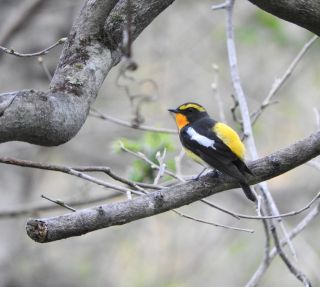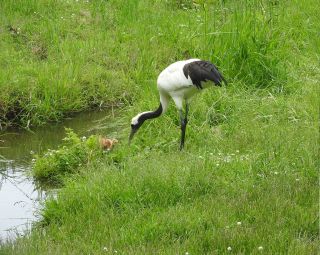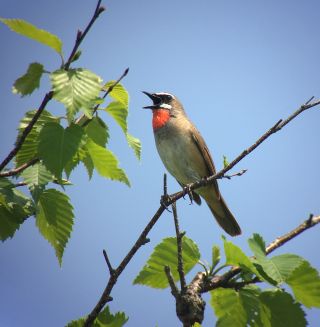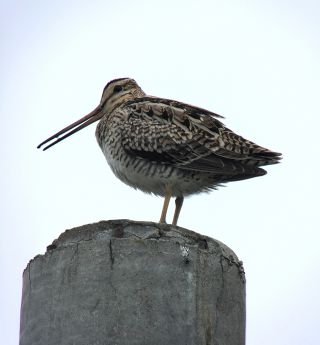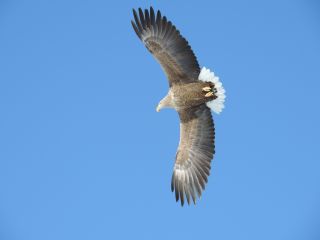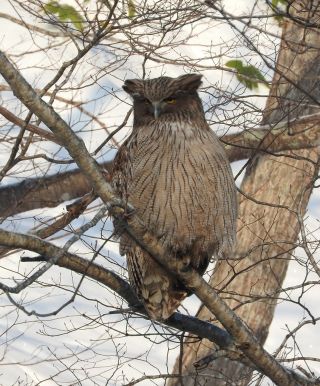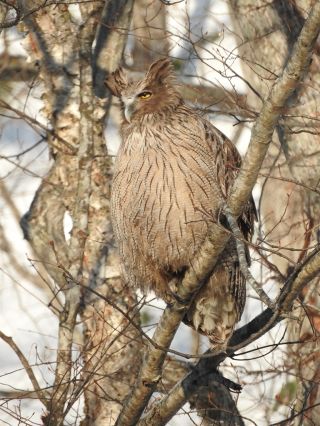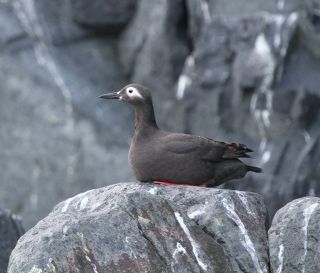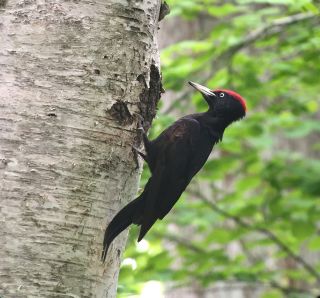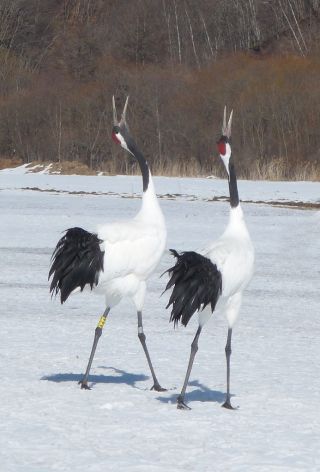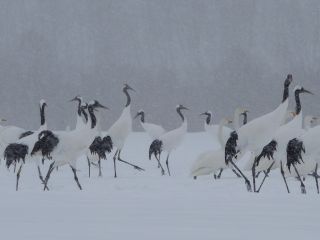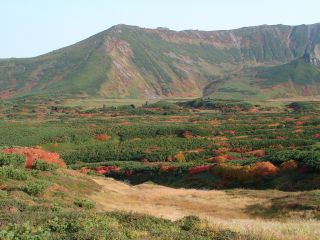A brilliant yellow flash in the forest is evidence that the Narcissus Flycatchers have arrived for the summer and that the males are not only singing, but displaying – fluffing out their rump feathers until they resemble a yellow ball © Mark Brazil
My Birding Paradise: Hokkaido II
By Mark Brazil | Dec 22, 2017
I have been writing about the wildlife of Hokkaido since the early 1980s and Hokkaido is now widely known as one of the top winter birding and wildlife photography locations on Earth. It is rapidly claiming its place as a renowned year-round destination.
Hokkaido is home to a number of eye-catching iconic species: the resident Red-crowned Crane and Blakiston’s Fish Owl, the winter visiting Whooper Swan and Steller’s Eagle, and the summer breeders Spectacled Guillemot and Siberian Rubythroat.
Situated on the East Asian Flyway, a migratory route connecting northeast Asia with Southeast Asia and Australasia, Hokkaido offers avian residents, summer visitors, winter visitors, and long-distance migrants.
Continuing from Part 1
Summer
Spring slowly gives way to summer as the marshes and forests of Hokkaido begin to show hints of green and the first flowers of spring, the creamy white magnolias and the snow-white skunk cabbages, appear. The first migrant breeders arrive in the greening forests and the delightful songs of colourful summer birds such as Siberian Blue Robin, Red-flanked Bluetail, Narcissus Flycatcher, Blue-and-white Flycatcher, and Eastern Crowned Warbler, quickly rival those of the resident Japanese Tit, Varied Tit, Coal Tit and Marsh Tit and the drumming of the resident woodpeckers (White-backed, Great Spotted, Grey-headed, Japanese Pygmy, Black).
The finest songster of spring, the Japanese Bush Warbler, occupies a place in the Japanese mind akin to that of the Nightingale in Europe. This bird of haiku and Japanese literature has a song that literally explodes from the dwarf-bamboo undergrowth of Hokkaido’s forests. Its song is the true marker of the arrival of summer.
As the days lengthen and become warmer, it is time to head upwards into the mountains, or to the coastal marshes in search of birds. In the montane forests Japanese Robin, Sakhalin Leaf Warbler, Grey Bunting, Brown-headed Thrush and Siberian Thrush are already singing, and the summer cuckoos (Oriental, Common, and Northern Hawk) are calling day and night and seeking out nesting birds to parasitize.
Near the treeline, in the Japanese Stone Pine zone, the Japanese Accentor, Spotted Nutcracker and Pine Grosbeak are all target birds, while overhead Pacific Swifts scream and White-throated Needletails hurtle past on their high-speed aerial missions in search of insect prey. Alpine flowers come into bloom throughout the late spring and summer months with numerous different species appearing each week, making every hiking trip into the mountains a delight, even if birds are hard to find.
Meanwhile, down in the coastal marshes, the resident Red-crowned Cranes have already hatched their chicks, and the reedbeds now resound to the songs of the Black-browed Reed Warbler. Hokkaido is an excellent area for buntings in summer too. These include Meadow, Chestnut-eared, Masked (or Black-faced), Grey, and Common Reed buntings. The fringes of the marshes and the rank grasses and vegetation along woodland, field, and coastal margins are now loud with the vibrant songs of Sakhalin Grasshopper Warbler, the reeling sounds of Lanceolated Warbler, and the click-clack of Stejneger’s Stonechat. Middendorff’s Grasshopper Warblers make aerial display flights above the marshland vegetation as they sing, but most delightful of all is to watch as a Siberian Rubythroat sings from a bush top, with its glowing ruby throat pulsating with both sound and colour.
Perhaps the most dramatic “songster” of summer is Latham’s Snipe. This extraordinary shorebird spends its winters in southeastern Australia and Tasmania, but breeds here in Hokkaido. Known locally as the “Kaminari-shigi” (or thunderbird!) its dramatic undulating display flight above the marshes involves it climbing high into the sky giving hoarse “tsu-biyaku, tsu-biyaku, tsu-biyaku” calls, then plunging into a steep dive during which its stiff outer tail-feathers vibrate, rattle and drum, thrumming with a strange “gwo-gwo-gwo” sound, before the bird swoops upwards once more calling as it goes.
White-tailed Eagles breed locally and are often found around the coastal marshes, along major rivers and at lakes inland during summer. There they hunt duck, gulls, and fish, and provide a dramatic sight as they soar overhead.
The highly aerial Eurasian Hobby is another summer visitor raptor and one that is both vocal and demonstrative as it hawks and hunts for dragonflies and other winged insects, making dramatic dashes and swoops as it chases them across the landscape.
As dusk falls on summer evenings, Hokkaido’s other summer visiting shorebird, the Eurasian Woodcock, can be seen beating the bounds of its territory, flying circuits above the forest, calling as it goes. Here and there, at strictly protected sites in east Hokkaido, pairs of Blakiston’s Fish Owl are now raising their precious young. As the calls of the woodcock fade, the deep duetting calls of the fish owl boom out over the riverine forests, and the high-pitched begging calls of their young seem incessant.
Beneath the cliffs of the Shiretoko Peninsula, and along the rocky shores of southeast Hokkaido and the islands off the west coast, a seabird – the Spectacled Guillemot – with a very restricted range can be found. Its high-pitched whistling calls carry over the sound of the sea, and in its breeding plumage it sports bright red feet, a red lining to its mouth and sooty black plumage set off by white spectacles. On Teuri Island, off the west coast, the Spectacled Guillemot is joined by small numbers of Common Guillemot (Common Murre) and by many thousands of Hokkaido’s most abundant seabird – the Rhinoceros Auklet. These auklets forage by day far out at sea, but return in enormous numbers to the island at dusk to enter their breeding burrows. To watch these birds returning at night is another of Hokkaido’s great avian spectacles that is not to be missed.
Autumn
Autumn colours come early to the higher mountains of Hokkaido, with the leaves of alpine flowers reddening in late August and early September, followed soon afterwards by the fiery-leaved Rowan trees. As the days shorten and cool, the upland birds descend southwards and there is a steady draining away of the summer birds that seemed for a few months at least to carry life into the forests. Amongst the last summer migrants to leave are the somewhat hardier Oriental Turtle Dove and White-bellied Green Pigeon, which take advantage of the fruiting shrubs and vines in the forest. With the first frosts, then snows, of autumn, the higher mountains and their forests turn white and silent except for the chattering of flocks of Dusky Thrushes as they move through the island stripping trees of their berries before they move on southwards.
This is the season to focus on the lowlands, on the woodlands and coastal marshes. Few species of duck breed in Hokkaido, though Mandarin Duck and Eastern Spot-billed Duck are notable exceptions. However, as summer wanes towards autumn, large flocks of water birds appear from their breeding grounds in Russia, and Hokkaido’s wetlands become significant staging areas for them as they migrate southwards. Huge flocks of Eurasian Wigeon, Northern Pintail, and Eurasian Teal appear at river mouths and coastal lagoons and are joined by smaller numbers of Falcated Duck, Gadwall, Mallard and Northern Shoveler. With them there are sometimes small flocks of migratory shorebirds including Grey-tailed Tattler and Red-necked Stint.
Soon the geese will return, bound for their Japanese wintering grounds. Their flocks are swollen now with the families they have raised in Russia. Diminutive Brent Goose favour the coastal marshes and the Zostera beds of bays around east and southeast Hokkaido, and they are soon joined by busy and attractive flocks of Common Merganser, Red-breasted Merganser, Common Goldeneye, Greater Scaup, Siberian Scoter, Black Scoter, Long-tailed Duck, and the delightful Harlequin Duck.
Autumn storms bring more and more seabirds in sight of land, including Northern Fulmar, auklets and even, on occasions, shearwaters and albatrosses. Coastal marshes also attract migratory raptors such as Hen Harrier and Short-eared Owl, which can be found in the late afternoon quartering the wetlands in search of rodents and small birds. Less common, but also possible, is the Rough-legged Buzzard, readily identified by its broad, dark-tipped white tail and its habit of hovering while hunting.
While most summer birds have fled the impending winter, and leaf fall makes the resident birds more visible, one bird, the Hazel Grouse, begins to “sing” again for a brief period. Its high-pitched whistled call gives away the presence of this northern forest grouse.
At this season, the Ainu god of the marshes “Sarurun Kamuy”, also known as the Red-crowned Crane begins to wander away from the marshes where they have bred. Pairs, with their single or twin offspring, visit harvested maize fields in search of any maize kernels left behind. There they gather with other families and form into small flocks. As they move back and forth each day between their foraging grounds and their riverine roost sites they gather other birds to them until by late autumn sighting flocks of more than a hundred cranes together is not uncommon. Soon the cranes will begin to gather at their winter feeding and roosting sites in the Kushiro and Tsurui areas of east Hokkaido; there they will become the major attraction for visiting wildlife photographers, not only from Japan, but from around the world.
Year Round
Much changes in Hokkaido from season to season, yet some things remain constant. Despite the severity of the winter in Hokkaido, a number of species can be found here throughout the year, including during the coldest period of mid-winter, though their numbers may be swollen then by relatives fleeing harsher conditions and arriving from further north in Russia.
Among the resident birds, the Black-eared Kite is ubiquitous. This common scavenging bird of prey can be found around all coasts and over all lowland habitats as it glides and soars, seeking out dead items to scavenge. The Eastern Buzzard is a more active predator of voles and mice; it is also widespread, though nowhere is it as common as the kite. It is most frequently encountered sitting atop roadside trees and poles, which it uses as lookout posts while hunting.
Along the faster flowing rivers of Hokkaido one can find the largest of the kingfishers, the Crested Kingfisher. This boldly pied bird forages for fish from favourite perches along the riverside. Meanwhile, along the water’s edge, and on rocks out in the water look for the dumpy Brown Dipper, which forages for aquatic insects by dipping and diving beneath the rushing water.
In the forests, Hokkaido’s various woodpeckers, Eurasian Jay, Brown-eared Bulbul, Goldcrest, Eurasian Wren, Eurasian Nuthatch and Eurasian Treecreeper are all resident. Around the forest edge, across farmland and along the coasts, two members of the crow tribe are ubiquitous scavengers: the more slender-billed Oriental (or Carrion) Crow, and the heavy-beaked Japanese (or Large-billed) Crow. Meanwhile in and around towns the Eurasian Tree Sparrow is a year-round presence.
In conclusion:
Whatever the time of year, Hokkaido offers the birder, birdwatcher and bird photographer a wealth of subjects on which to focus. And while birding there are also mammals, reptiles, amphibians and a host of butterflies and dragonflies to look for too.
Enjoy Hokkaido, the wildlife here is fantastic!
Outro
If you would like to read more about Japan’s natural (and un-natural) history, then you may enjoy Mark’s collection of essays entitled The Nature of Japan: From Dancing Cranes to Flying Fish.
Author, naturalist, lecturer and expedition leader, Dr Mark Brazil has written his Wild Watch column continuously since April 1982, first in The Japan Times for 33 years, and since 2015 here on this website. All Wild Watch articles dating back to 1999 are archived here for your reading pleasure.
Two handy pocket guides The Common and Iconic Birds of Japan and The Common and Iconic Mammals of Japan have also been published and along with The Nature of Japan are available from www.japannatureguides.com

